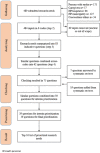Transitional care for patients with acute stroke-A priority-setting project
- PMID: 35501973
- PMCID: PMC9327821
- DOI: 10.1111/hex.13517
Transitional care for patients with acute stroke-A priority-setting project
Abstract
Background: The scope of this priority-setting process is communication and collaboration in transitional care for patients with acute stroke. Actively involving persons with stroke and their family caregivers is important both in transitional care and when setting priorities for research. Established priority-setting methods are time-consuming and require extensive resources. They are therefore not feasible in small-scale research. This article describes a pragmatic priority-setting process to identify a prioritized top 10 list of research needs regarding transitional care for patients with acute stroke.
Methods: A pragmatic priority-setting approach inspired by the James Lind Alliance was developed. It involves establishing a user group, identifying the research needs through an online survey, analysing and checking the research needs against systematic reviews, culminating in an online prioritization of the top 10 list.
Results: The process was completed in 7 months. A total of 122 patients, family caregivers, health personnel and caseworkers submitted 484 research needs, and 19 users prioritized the top 10 list. The list includes the categories 'patients and caregivers' needs and health literacy', 'health personnel's common understanding', 'information flow between health personnel and patients and caregivers', 'available interventions and follow-up of patients and caregivers', 'interaction and collaboration between health personnel and caseworkers across hospital and primary healthcare' and 'disabilities after stroke'.
Conclusion: This paper outlines a pragmatic approach to identifying and prioritizing users' research needs that was completed in 7 months. The top 10 list resulting from this priority setting process can guide future research relating to communication and collaboration during the transition from hospital to the community for patients with stroke.
Patient and public contribution: Members of three stroke organizations participated in the advisory group. They gave feedback on the scope and the process, distributed the surveys and prioritized the top 10 list. Persons with stroke and their caregivers submitted research needs in the survey.
Keywords: collaboration; communication; priority setting; research needs; stroke; transitional care; user involvement.
© 2022 The Authors. Health Expectations published by John Wiley & Sons Ltd.
Conflict of interest statement
The authors declare no conflicts of interest.
Figures
Similar articles
-
Needs-led research: a way of employing user involvement when devising research questions on the trust model in community home-based health care services in Norway.Res Involv Engagem. 2021 Jun 22;7(1):43. doi: 10.1186/s40900-021-00291-0. Res Involv Engagem. 2021. PMID: 34158122 Free PMC article.
-
Top 10 research priorities relating to life after stroke--consensus from stroke survivors, caregivers, and health professionals.Int J Stroke. 2014 Apr;9(3):313-20. doi: 10.1111/j.1747-4949.2012.00942.x. Epub 2012 Dec 11. Int J Stroke. 2014. PMID: 23227818
-
Top 10 (plus 1) research priorities for expectant families and those with children to age 24 months in Alberta, Canada: results from the Family Research Agenda Initiative Setting (FRAISE) priority setting partnership project.BMJ Open. 2021 Dec 9;11(12):e047919. doi: 10.1136/bmjopen-2020-047919. BMJ Open. 2021. PMID: 34887269 Free PMC article.
-
Priorities of patients, caregivers and health-care professionals for health research - A systematic review.Health Expect. 2020 Oct;23(5):992-1006. doi: 10.1111/hex.13090. Epub 2020 Jul 9. Health Expect. 2020. PMID: 32643854 Free PMC article.
-
Determining research priorities through partnership with patients: an overview.Semin Dial. 2015 Mar-Apr;28(2):141-6. doi: 10.1111/sdi.12325. Epub 2014 Nov 30. Semin Dial. 2015. PMID: 25440522 Review.
Cited by
-
Are physiotherapists and occupational therapists following the guidelines for discharge summary?-An analysis of the content of physiotherapists' and occupational therapists' discharge summaries and their adherence to stroke guideline recommendations.PLoS One. 2024 Sep 3;19(9):e0308039. doi: 10.1371/journal.pone.0308039. eCollection 2024. PLoS One. 2024. PMID: 39226253 Free PMC article.
-
Ten Priorities for Research Addressing the Intersections of Brain Injury, Mental Health and Addictions: A Stakeholder-Driven Priority-Setting Study.Health Expect. 2024 Aug;27(4):e14136. doi: 10.1111/hex.14136. Health Expect. 2024. PMID: 38990165 Free PMC article.
-
Patient and public involvement in Nordic healthcare research: a scoping review of contemporary practice.Res Involv Engagem. 2023 Aug 30;9(1):72. doi: 10.1186/s40900-023-00490-x. Res Involv Engagem. 2023. PMID: 37649111 Free PMC article.
-
Transitioning to home and beyond following stroke: a prospective cohort study of outcomes and needs.BMC Health Serv Res. 2024 Apr 10;24(1):449. doi: 10.1186/s12913-024-10820-8. BMC Health Serv Res. 2024. PMID: 38600523 Free PMC article.
-
Stroke patient and stakeholder engagement (SPSE): concepts, definitions, models, implementation strategies, indicators, and frameworks-a systematic scoping review.Syst Rev. 2024 Oct 31;13(1):271. doi: 10.1186/s13643-024-02686-y. Syst Rev. 2024. PMID: 39482702 Free PMC article.
References
-
- The Norwegian Directorate of Health . Norwegian guideline on management and rehabilitation of stroke; 2017. Accessed August 2021. www.helsedirektoratet.no/retningslinjer/hjerneslag
-
- Fjærtoft H, Skogseth‐Stephani R, Indredavik B, Bjerkvik T, Varmdal T. Norsk hjerneslagregister‐Årsrapport 2019‐Med plan for forbedringstiltak Register. 2020. Accessed December 16, 2021.https://www.kvalitetsregistre.no/sites/default/files/1_arsrapport_2019_n...
-
- NTOCC . Transition of care measures. The National Transitions of Care Coalition. Accessed June 20, 2021. https://static1.squarespace.com/static/5d48b6eb75823b00016db708/t/5d49bc...
MeSH terms
LinkOut - more resources
Full Text Sources
Medical



